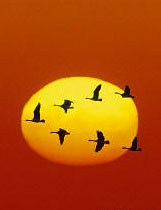Feb 20
2013
Five Facts that High-flying Teams Can Learn from Geese

When my wife forwarded me the following heartwarming link to a tender, but powerful presentation about leadership and teamwork, and later in the day I came across a piece titled “5 Facts that Top Teams Learn From Geese,” I figured it was some sort of sign so thought I’d share with the readers of Electronic Health Reporter.
The link to the presentation is here, and it’s worth a look. Even though it’s a slide show, I understand if you don’t have the time or the desire to follow a link. As such, I’ve included the piece, from HR Pulse (thanks to writer Charles Lubbe for compiling this post, his in full below).
Is it about health IT? No. But, it’s about leadership and taking common sense steps to help improve your teams and your organizations. These are simple tips that apply to every business and should be embraced by every leader — and, who doesn’t like an animal story?
Fact #1: As each bird flaps its wings, it creates a “current” that lifts the bird following it. By flying in a V formation, the whole flock adds 71 percent more flying range than if one bird flew alone.
Lesson learned: People who share a common direction and sense of community can get where they are going quicker and easier if they travel on the strength of one another. The clearer the vision or certainty of a team, the more courage they demonstrate in achieving their results and the less they concern themselves with individual effort.
Fact #2: Whenever a goose falls out of formation, it suddenly feels the drag and resistance of trying to fly alone and quickly gets back into formation to take advantage of the lifting power of the bird immediately in front of it.
Lesson learned: If we have as much sense as geese, we will stay in formation with those who are ahead of where we want to go and be willing to accept their help and give ours to others. Top teams encourage discipline and look forward to opportunities for positive criticism, ensuring that the entire team reaps the reward.
Fact #3: When the lead goose gets tired, it rotates back into the formation and another goose flies at the point position.
Lesson learned: It pays to take turns doing the hard tasks and sharing leadership. Teams that are focused on their vision understand situational leadership and don’t need to be micro managed.
Fact #4: The geese in formation honk from behind to encourage those up front to keep up their speed.
Lesson learned: We need to make sure our “honking” from behind is encouraging, and not something else. Teams that place a value on regular check in and feedback hold their shape.
Fact #5: When a goose gets sick, is wounded or shot down, two geese drop out of formation and follow it down to help and protect it. They stay with it until it is able to fly again, or dies. They then launch out on their own, with another formation, or they catch up with their flock.
Lesson learned: If we have as much sense as geese do, we too, will stand by each other in difficult times as well as when we are strong.
I’d love to know your thoughts and if you think the previous points are worth the read, and more importantly, if they are worth implementing.